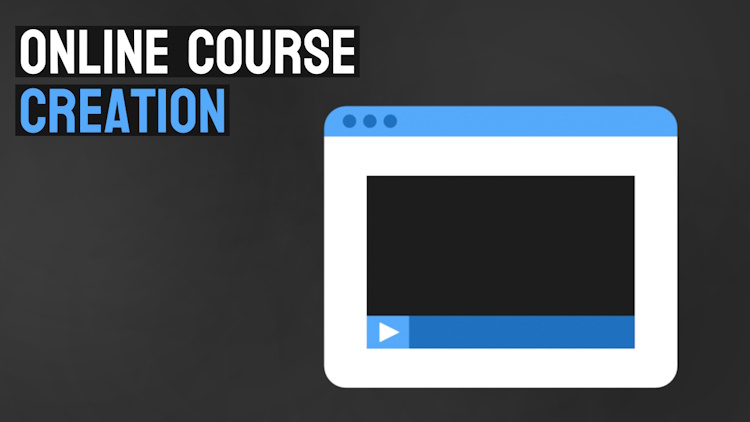How to Create an Online Course That Makes Money in 2025
Do you have a skill that you could teach to others in the form of an online course? Keep reading to learn how you can create your own course and earn money with it.

The information in this article is for educational and informational purposes only. We do not guarantee that you will earn any money.
Some of the links in this article may be affiliate links, which can provide compensation to us at no cost to you.
How to Create an Online Course?
Making an online course is relatively easy and straightforward. If you own at least a smartphone and basic IT skills, you will be able to create your own course quite effortlessly.
Create an online course by following these 6 steps:
- Planning the content
- Writing the script
- Shooting the video
- Recording the audio
- Editing the video
- Creating the store page
Online Course Creation Steps
Step 1: Planning the Content
The first thing you need to think about is the topic of your online course. It should be something that interests you and that you know enough about to be able to share your knowledge with others. I did my first course on 3D modeling, because back in the day I used to make 3D models daily, so I had the skill fresh in my mind.
Once you have figured out the topic, think of answers to the following questions:
What is the target audience of the course? Is it meant for beginners, intermediates or people that are already experienced in the skill?
 Expertise is not required
Expertise is not requiredWhat are the requirements for the course? Do the students need to have, for example, a specific device or software that is needed in the lectures of your course?
What will the students learn in the course? List the most important topics that you will cover in the course.
Step 2: Writing the Script
Once the content of your course is clear to you, start writing a script based on the topics you listed. To write the script, use a text editor like Google Docs.
Teach only one topic in each lecture to keep the course structure easily understandable. In my opinion, the length of the video lecture should be something between 3 and 10 minutes, because usually people like to learn a little bit at a time. So try to estimate the length of the text you write accordingly.
Feel free to make your course as lengthy as you want, but aim for at least 2 hours so that people feel that your course is comprehensive enough.
If you are fluent in other languages besides English, I recommend that you make your course in those languages as well. Personally, I always do my courses first in Finnish and then later in English. There is obviously a lot less competition in Finland but I’m able to stand out and based on my experience it’s totally worth it. It doesn’t take very long to make multiple versions of a course that has already been created.
Step 3: Shooting the Video
When the script is written, it’s time to shoot the video material of the course. There are several different filming styles, choose the one you like best.
You can either film yourself or remain anonymous. You can teach on a computer by making, for instance, a slide show or physically, for example, by drawing and writing on a whiteboard. You can record the speech while shooting the video or record the audio later.
The easiest and fastest way to handle both video and sound at the same time is to film yourself in talking head style. That way, all you have to do is read your on-screen script out loud.
If you plan to teach using a whiteboard, for example, make sure that the lighting is good and that the text you write on the board is easy to read. The video doesn’t have to be of top quality, usually a video shot with a phone works just fine.
If you want to record your computer screen and your speech at the same time, use a program like OBS Studio. There are many tutorials on the web for using the program.
If you plan to teach using a slide show, Google Slides is a good solution for that. Visualizing your teaching improves your students’ ability to learn, so make sure to add images, diagrams and videos to your course lectures.
In my first course, I taught how to use a 3D modeling software. I was recording my primary screen while following my script on my second screen. I didn’t record my speech during shooting the video because it wasn’t smooth enough.
Step 4: Recording the Audio
The next step is to record the Voice-over. If you are going to record your speech while shooting the video, you can skip this step.
Audio is an aspect worth investing in when making an online course. You should focus on both your way of speaking and the quality of the audio.
Try to sound engaging and clear when speaking. Your speech should be pleasant to listen to for a longer time, so try to avoid, for example, a monotonous voice.
When recording your speech, try to minimize echo and external sounds. When I was creating my first course, I built a microphone booth from a light metal frame and blankets, which allowed me to completely eliminate the echo and the hum of my computer. I read the script from my phone, which I hung at the back of the booth, behind the microphone.

If you are going to record the audio track afterwards with a microphone connected to your computer, you can do it with, for instance, the audio recording and editing program, Audacity. Alternatively, you can record the Voice-over later, during the video editing phase, inside the video editor.
Step 5: Editing the Video
When you are done with the video and audio of your course, you need to import them to a video editing program. DaVinci Resolve is a great option for anything from simple video trimming to advanced editing.
In my opinion, basic video editing is one of the easiest technical skills you can learn. Although video editors may seem complicated at first, you can easily learn to use them in just a couple of days. I have created an online course on the subject, which you can find here. The course covers everything a beginner needs to know about video editing in DaVinci Resolve.
If your speech is part of the video file you shot, all you have to do is to cut out the unnecessary parts from it. There should always be something happening in the video so that the viewer attention stays on your video.
If you are going to record the speech after the video shooting phase, you must edit the audio track to fit the video.
Provided that you haven’t recorded the soundtrack at this point, you can record the Voice-over inside the video editor, on top of the already cut video.
In case you want to invest more in the video editing phase, you can use zoom and highlights in points where you want to emphasize something. You can also add, for example, text and images on top of the video.
After the video has been edited, it must be rendered, in other words, made into a playable video file. Render each lecture as a separate video.
Step 6: Creating the Store Page
After you have made all the lectures into videos, the next step is to choose which online course platform you will use to sell your course.
There are two types of online course platforms. In this article, I talk about them with the names Course Platform A and Course Platform B.
Course Platform A is a platform that has an existing audience. In my opinion, this is the only good thing about this type of platform, because you might make money just by adding your course on the platform. What about the downsides? Well, there are a lot of them.
Based on my own experience, the downsides of Course Platform A are the following:
- there are already hundreds of courses on the site so competition is tough
- you don’t get your students’ email addresses for your own use
- promoting your own brand is very limited
- your course must meet the requirements defined by the platform
- the platform can hide your course if it’s not doing well enough
- one of these platforms pays you less than 40% of sales that come organically through the site, so you earn less than 4 dollars when someone buys your course for 10 dollars
- some time ago, one of these course platforms unexpectedly dropped the monthly income of instructors to about 30% from what it had been before, so these course platforms can make unpredictable changes that affect your income radically
Platforms like Course Platform A have so many disadvantages that I cannot recommend them.
Let’s now talk about Course Platform B, starting with its downsides. The only downside to a platform like this is that the site doesn’t have an existing audience. This means you must direct people to your course’s store page from, for example, your social media channels.
The advantages of Course Platform B are as follows:
- your courses can be found on your personal website, so you don’t have to compete with anyone
- you get your students’ email addresses for your own use and you can also collect the email addresses of people visiting your site using an email form
- you can make your course’s store page look exactly the way you want and you can also create other pages such as a home page where you get to introduce yourself, your social media channels and all of the courses you have created
- you get to decide the price of each course yourself, sell course bundles and create discount coupons
- you have full power to decide what kind of content your course contains
One of these course platforms is FreshLearn, which is the best platform in my opinion. I talk more about it in our article: the best course platforms.
 The best course platform for selling courses
The best course platform for selling coursesAll you have to do is to create an account on FreshLearn, upload your video lectures to the platform and build a store page for your course using their simple page builder.
When you start making a store page for your course, you should list the three points mentioned in the first step of this article, among other things. You can also make an introduction video for the course and add it to the beginning of the store page.
On the store page, you should use popular terms related to your field, because they increase the ranking of your page in search engines. People might search using terms like these: “how to make 3D models”, “3D modeling for beginners” or “how to start a 3D visualization business”, as an example.
How to Make Money With an Online Course?
An online course is a digital product that needs to be created only once, after which it may generate passive income, at best daily, for several decades. However, the lectures of the course should be updated if they deal with, for example, some software, because new versions of them are published from time to time, in which case outdated information may no longer work.
So far I have created 4 online courses in both Finnish and English. Although at no point have I focused solely on creating courses, they have been a nice side income along with other jobs.
You should know that this is not some get-rich-quick scheme. It takes something from a few weeks to a few months to create a great course.
The more courses you create, the more money you can earn. When an instructor advertises their other courses in one of their course’s lectures, on their website and on social media, a student may buy more than one course from them. This is kind of a snowball effect.
At this point, however, your goal should be to create your first course. Try to make it as good as possible, but don’t aim for perfection. Lectures can always be improved afterwards.
You should also create a social media channel and start gathering followers. Create, for example, a YouTube channel where you offer free content related to your course and direct viewers to your course’s store page. You don’t need to have tens of thousands of followers to make money with your course. According to my experience, there are already a lot of potential students among a couple of hundred followers.
Creating online courses can be a good side business alongside work or studying. When you are ready to start creating and selling courses, I recommend using FreshLearn as your course platform.

